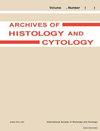Olig genes are upregulated in oligodendrocyte precursor cells in the injured central nervous system
Q4 Medicine
引用次数: 0
Abstract
The Olig gene family encodes basic helixloop-helix (bHLH) transcription factors and plays a critical role in oligodendrogenesis during development. We examined whether the Olig genes are involved in pathological conditions such as the injured brain or spinal cord by in situ hybridization. Olig1 mRNA was detected in cells surrounding necrotic tissue. The signal intensity of Olig1 mRNA gradually increased 2 to 7 days and decreased by 14 days after injury. Olig2 mRNA was expressed in a similar pattern and was colocalized with Olig1 mRNA. Similar results were obtained for the expression of Olig1 and Olig2 mRNAs in spinal cord injury. When we compared the mRNA expression pattern of Olig1 with that of NG2 proteoglycan and platelet-derived growth factor receptor α (PDGFRα), markers for oligodendrocyte precursor cells (OPCs), by double labeling in situ hybridization, Olig1 mRNA was co-localized with mRNAs for NG2 proteoglycan and PDGFRα 7 days after brain injury, suggesting that Olig mRNAs were expressed in OPCs. These findings suggest that the Olig transcription factors regulate differentiation of oligodendrocytes in the injured CNS as well as in the developing CNS.在中枢神经系统损伤的少突胶质细胞前体细胞中寡基因上调
oliggene家族编码基本螺旋环-螺旋(bHLH)转录因子,在发育过程中对少突发生起关键作用。我们通过原位杂交检查了oliggenes是否参与病理状况,如脑或脊髓损伤。坏死组织周围细胞中检测到Olig1 mRNA。损伤后2 ~ 7 d, Olig1 mRNA信号强度逐渐升高,14 d逐渐降低。Olig2 mRNA以类似的模式表达,并与Olig1 mRNA共定位。在脊髓损伤中,Olig1和Olig2 mrna的表达也得到了类似的结果。当我们通过双标记原位杂交比较Olig1 mRNA与NG2蛋白聚糖和血小板衍生生长因子受体α (PDGFRα) mRNA的表达模式时,我们发现Olig1 mRNA在脑损伤后7天与NG2蛋白聚糖和PDGFRα mRNA共定位,表明Olig1 mRNA在OPCs中表达。这些发现表明,寡糖转录因子在损伤的中枢神经系统和发育中的中枢神经系统中调节少突胶质细胞的分化。
本文章由计算机程序翻译,如有差异,请以英文原文为准。
求助全文
约1分钟内获得全文
求助全文
来源期刊

Archives of histology and cytology
生物-细胞生物学
自引率
0.00%
发文量
0
期刊介绍:
The Archives of Histology and Cytology provides prompt publication in English of original works on the histology and histochemistry of man and animals. The articles published are in principle restricted to studies on vertebrates, but investigations using invertebrates may be accepted when the intention and results present issues of common interest to vertebrate researchers. Pathological studies may also be accepted, if the observations and interpretations are deemed to contribute toward increasing knowledge of the normal features of the cells or tissues concerned. This journal will also publish reviews offering evaluations and critical interpretations of recent studies and theories.
 求助内容:
求助内容: 应助结果提醒方式:
应助结果提醒方式:


